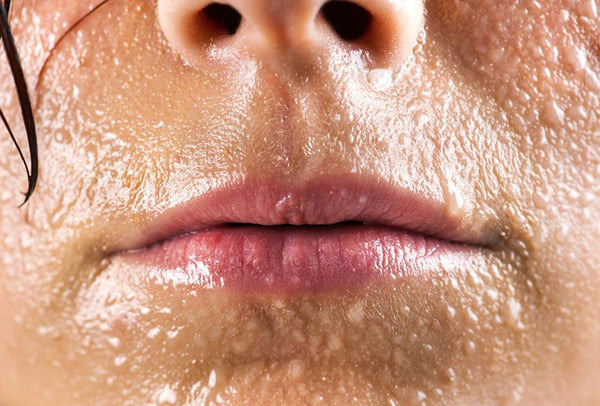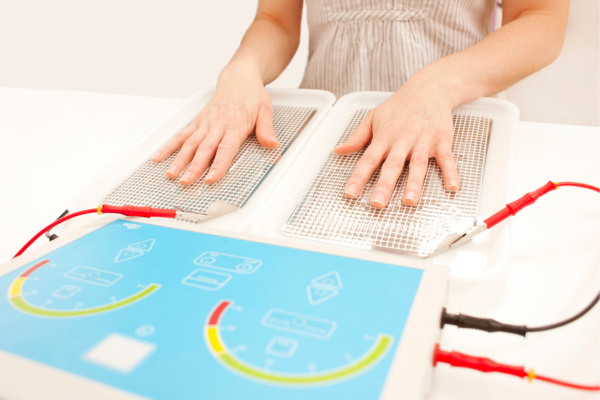THE SHOCKING NEW TREND - Botox and iontophoresis to stop you sweating
There's a shocking new trend pushing the boundaries of conventional solutions – Botox and Iontophoresis.
While these procedures are primarily intended for individuals with hyperhidrosis, a condition characterised by abnormal and excessive sweating, celebrities and everyday people are now exploring these extreme methods to manage what is otherwise a normal bodily function.
In this blog, we'll dive into the details of these extreme approaches that people are adopting to bid farewell to sweating woes.
WHAT IS HYPERHIDROSIS?
Hyperhidrosis involves excessive sweating that is not always linked to heat or physical activity. It is characterized by sweating beyond what the body requires for temperature regulation. Sweating, a natural physiological process, aids in temperature regulation as it evaporates from the skin, providing a cooling effect during heat or exercise. Additionally, individuals may notice increased sweating when anxious or nervous. However, for approximately 3% of people with hyperhidrosis, sweating can be nearly constant.

The cause of hyperhidrosis is not precisely known, but it is believed to stem from overactive nerves that control sweating. While hyperhidrosis often begins in childhood or adolescence, it can onset at any point in life. A genetic element may contribute, as individuals with a family history often experience excessive sweating of the hands.
Those with hyperhidrosis may encounter challenges in work situations, such as job interviews or meetings where handshakes are expected, leading to anxiety. Their social lives can also be impacted, with many individuals feeling embarrassed by their persistent sweating.
Due to the stigma associated with hyperhidrosis, some affected individuals may not seek medical help or may be unaware that it is a medical condition. Even for those who do seek help, challenges may arise in being taken seriously or obtaining access to specialists, with treatment often considered a low priority.
For the 3 in every 100 people affected by hyperhidrosis, medical treatments may become necessary. However, the concern lies in the increasing number of individuals in the remaining 97% exploring last-resort treatments to address what is essentially a normal bodily function.
WHAT IS BOTOX?

Botulinum toxin (aka Botox) is a neurotoxin produced by the bacterium Clostridium botulinum and one of the most poisonous biological substances known.
But don’t worry…Botox is safe if used appropriately by a medical professional and Botulinum toxins now play a very significant role in the management of a wide variety of medical conditions.
Botox is most well known as a cosmetic treatment to smooth facial wrinkles by temporarily paralyzing muscles. Doctors also use Botox to treat neuromuscular conditions like migraine, muscle spasms, and hyperhidrosis.
HOW DO BOTOX INJECTIONS WORK TO TREAT SWEATING?
Botox injections block the release of the neurotransmitter acetylcholine, which binds with your sweat glands to signal the release of sweat.
Normally, your nervous system activates your sweat glands when your body temperature rises. This is how your body automatically cools itself. In people with hyperhidrosis, however, the nerves that signal the sweat glands are overactive.
When you receive Botox injections directly into the area of your body that commonly sweats, your nerves are essentially paralyzed. When your nerves can’t signal your sweat glands, you don’t sweat.

Currently, Botox has only been approved for the treatment of underarm sweating. Studies have found varying results, but there’s ample evidence that Botox can reduce armpit sweat production by more than 50 percent for at least 6 months.
SIDE EFFECTS OF UNDERARM BOTOX
It’s reported that in rare cases, some side effects may occur after underarm Botox treatment. These are generally mild complications that subside in a few days.
The most common side effects of Botox for hyperhidrosis include the following:
- Nausea or vomiting
- Bruising and mild pain in the treated region
- Skin rashes
- Loss of bladder control
- Muscular weakness
- Difficulty breathing and swallowing
- Fever
- Dry mouth
WHAT IS IONTOPHORESIS?
During iontophoresis, a medical device uses mild electrical currents to deliver medication across biological membranes, often while your affected body part is submerged in water.
The currents are often delivered to the hands, feet, or armpits to block your sweat glands temporarily. Some feel a slight tingling sensation during the procedure, but the electrical current isn’t strong enough to shock you.

People often undergo 20- to 40-minute treatment sessions several times per week until sweating decreases to a desirable level.
At that point, treatments are scheduled less frequently, usually about once per week.
Iontophoresis treatments must be done regularly and before sweating increases to maintain results.
WHAT ARE THE POSSIBLE SIDE EFFECTS?
It is possible to experience the following side-effects when undergoing treatment.
Most commonly experienced on the day and at the site of treatment are:
- Tingling sensation, itchiness
- Mild reddening/irritation of the skin (which soon fades) If you suffer from eczema, it may worsen the condition
The following, though potentially can occur, are uncommon and greatly reduced by proper administration of treatment:
- Dry and cracked skin.
- Bruising or blisters.
- A risk that open lesions may form, potentially leading to scarring.
- A mild electric shock if patients are non-compliant with method of treatment. The electric current used during iontophoresis is not strong enough to cause a harmful shock but it could startle you, if you were to remove the ‘sponge pockets’ containing the rubber electrodes during treatment.
- Mild electrical burn if the rubber electrode is touched whilst treatment is in progress
DON'T SWEAT IT
If you have genuine concerns about your sweating, seek medical advise from your GP or a qualified healthcare professional.
And if you just find yourself intrigued or seeking alternatives, perhaps consider a smaller leap first rather than electrifying or sticking needles in your armpits.
Why not try making the switch to a natural deodorant if you haven't already? It might not be as extreme, but sometimes the simplest solutions are just as effective and better for your overall health and wellbeing.

You may also be interested in reading our other blogs here









Leave a comment
Please note, comments need to be approved before they are published.